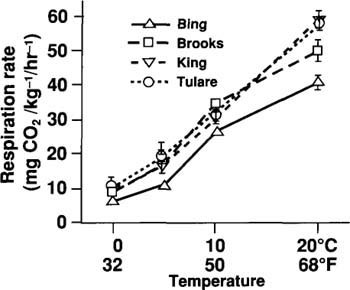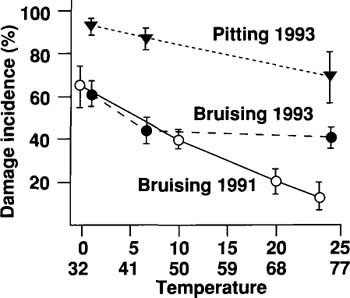All Issues
Cold ‘Brooks’ cherries suffer more pitting and bruising
Publication Information
California Agriculture 48(6):18-19.
Published November 01, 1994
PDF | Citation | Permissions
Abstract
The incidence of pitting and impact bruising on ‘Brooks’ sweet cherries was greatest when the flesh temperature was near 1 °C (34°F), intermediate near 10°C (50°F), and lowest near 20°C (68°F). Therefore ‘Brooks’ cherries should be handled at temperatures between 10° and 20°C (50° and 68°F) during packing to minimize surface damage. However, because of increased respiration rates at higher temperatures, cherries should be cooled to 0°C (32°F) within 4 to 6 hours of harvest.
Full text
The six ‘Brooks’ cherries on the right exhibit symptoms of pitting. Cherries handled at colder temperatures suffer more pitting and bruising damage.
The incidence of bruising and pitting (surface damage) limits shelf life in cherries by inducing rapid softening and decay and reduces consumer acceptance. Surface damage can result when fruit are dropped onto a hard surface, onto other fruit, or onto stems. The incidence of surface damage is positively correlated with the height of free fall, texture of the contact surface, and flesh temperature. Cherries that are cold at the time of the impact are more susceptible to bruising and pitting than warm cherries.
To develop postharvest temperature-management strategies to prolong the shelf life of ‘Brooks’ cherries (Prunus avium L.), it is necessary to understand the influence of temperature on surface damage susceptibility and respiration rate. Most pitting and bruising studies have been conducted on ‘Bing,’ ‘Lambert’ and ‘Van’ cherries grown under mild temperature conditions, so we decided to study the relationship between flesh temperature and pitting of ‘Brooks’ sweet cherries grown in the warmer temperatures of the southern San Joaquin Valley. We also compared the respiration rates of ‘Bing’ with ‘Brooks,’ ‘King’ and ‘Tulare’ cherries.
Temperature, surface damage
To study the relationship between temperature and surface damage in ‘Brooks’ cherries, we used 2.1 cm diameter fruit (size row 12) during two years, 1991 and 1993. During the 1991 season, ‘Brooks’ (harvested May 20), ‘Tulare’ (harvested May 22), ‘King’ (harvested May 29) and ‘Bing’ (harvested June 5) cherries growing in the Fresno area were harvested at commercial maturity, as determined by solid, bright red skin color. During the 1993 season, ‘Brooks’ cherries were harvested in the Fresno area at the bright red color (May 20) and at the mahogany color (May 25). The cherries were transported to the F. Gordon Mitchell postharvest facilities at the Kearney Agricultural Center in Parlier within 2 hours of harvest and hydrocooled until the desired flesh temperature for each fruit was reached.
Respiration rate
CO2 production for ‘Brooks,’ ‘Bing,’ ‘King’ and ‘Tulare’ cherries, with pedicels attached, was measured at 0°, 5°, 10° and 20°C (32°, 41°, 50° and 68°F). Cherries from each cultivar were enclosed in glass jars that were ventilated with air at a flow rate sufficient to avoid CO2 accumulation above 0.3%. Samples were allowed to equilibrate for 24 hours, and the generated CO2 was then measured with a Horiba PIR-2000R gas analyzer.
Fruit damage
To study the relationship between temperature and surface damage, ‘Brooks’ cherries, with pedicels attached, at 0°, 10°, 20° and 24°C (32°, 50°, 68° and 76°F) flesh temperature, were dropped stem end up from a height of 45 cm (17.7 inches) through a vertical PVC pipe (2.6 cm inside diameter) onto a slanted metal plate (1991 season). For the 1993 season, ‘Brooks’ cherries, with pedicels, at 1°, 7° and 26°C (34°, 44°, and 78°F), were dropped stem end up from a height of 7.5 cm (3.0 inches) onto a dimple belt instead of a metal plate. When dropped through the PVC pipe, the cherries with pedicels were not able to tumble and always hit bottom end down, thus standardizing impact location and facilitating the evaluation of bruising and pitting damage. Five replications of 15 fruit were used at each temperature. After impact, cherries were stored at 20°C (68°F) for 2 days before bruising was measured (1991 season) or at 1°C (34°F) for 14 days before pitting was measured (1993 season), then moved to 24°C (75°F) for 2 days before evaluation. Bruising injury (more than 2.0 mm in diameter or 3.1 mm2) was determined by external color and internal color and textural changes. Pitting was evaluated externally as flattened and/or darkened places, or as pits greater than 3.1 mm2 on the surface of the cherry.
Temperature effects
Respiration rate. CO2 production rate increased with temperature in all cultivars tested (fig. 1). ‘Bing’ cherries produced less CO2 than ‘Brooks,’ ‘Tulare’ and ‘King’ at each temperature. Respiration rates were similar among ‘Brooks,’ ‘Tulare’ and ‘King’ cherries at 0°, 5° and 10°C (32°, 41° and 50°F). At 20°C (68°F), ‘Brooks’ had a lower respiration rate than either ‘Tulare’ or ‘King,’ but a higher respiration rate than ‘Bing.’ Carbon dioxide production was 45 to 55 mg CO2/kg/hr at 20°C (68°F) for ‘Brooks,’ ‘Tulare’ and ‘King,’ suggesting that they may be more susceptible to rapid deterioration than ‘Bing’ (35 mg CO2/kg/hr at 20°C).
Impact damage
Flesh temperature at the time of impact significantly affected bruising incidence (P = 0.001). Internal and external bruising damage decreased as temperature increased (fig. 2). The incidence of impact bruising damage was higher when the flesh temperature was less than 10°C (50°F).
Fig. 1. Respiration rates of ‘Bing,’ ‘Brooks,’ ‘Tulare’ and ‘King’ cherry cultivars measured at 0°, 5° and 10°C (32°, 41° and 68°F). Bars indicate standard error.
Fig. 2. Relationship between cherry flesh temperature and damage susceptibility (% of fruit damaged) for ‘Brooks’ cherry during the 1991 and 1993 seasons. Bars indicate standard error.
Surface pitting
‘Brooks’ flesh temperature at the time of impact significantly affected surface pitting (P = 0.001) and bruising (P = 0.040). Pitting damage decreased as cherry temperature increased for this cultivar (fig. 2). Impact that occurred when flesh temperature was 1°C (34°F) induced significantly higher pitting damage levels than impact that occurred at 7°C (44°F) or 26°C (78°F) flesh temperature. Also, significant differences in severity of pitting occurred between 7° and 26°C (44°F and 78°F). Bruising was always higher on cold than on warm cherries (fig. 2). Bruising levels and the relationship between temperature and bruising severity were similar in the 1991 and 1993 studies.
Recommendations
‘Brooks’ cherries handled at temperatures near 1°C (34°F) suffer more pitting and bruising damage than those handled at temperatures above 10°C (50°F). Therefore, cooling can be done just before package filling (in-line hydrocooler) or by forced-air cooling soon after packaging. The new cherry cultivars (‘Brooks,’ ‘King’ and ‘Tulare’) had almost double the respiration rate of ‘Bing’ cherries at 20°C (68°F); therefore they should be cooled to 0°C (32°F) within 4 hours after harvest to reduce their deterioration rates and maximize postharvest life.







